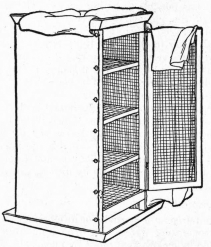Methods Of Keeping Foods Cool
Taken From A Manual Of Homemaking
Compiled By Martha Van Rensselaer and Flora Rose Helen Cannon
Of The Department Of Home Economics, New York College Of Agriculture At Cornell University
Some of the methods of keeping foods cool that were used by primitive people are still resorted to, sometimes with certain modifications. The use of vessels permitting evaporation, the running water of streams, caves or holes in the ground, packing with grasses, all have lent their principles to more elaborate cooling methods and refrigerating systems of to-day.
Refrigerators.
Ordinary household refrigerators, even of the best make with the best insulated walls, are by no means as effective in saving ice as might be desired. Three points to consider in purchasing a refrigerator are low temperature, dryness, and sanitation. The low temperature is obtained by ice and proper insulation. The ice compartment should be large enough to hold at least 50 or 75 pounds of ice and should be kept filled in order to avoid a fluctuation in temperature which is favorable to the growth of micro-organisms that cause food to spoil. The location of the ice compartment at the side is thought to be better than across the entire top. The door for icing is perhaps more convenient at the side than on the top. A rear icing-door can be made at a very small additional cost; if the refrigerator is to be placed where rear icing would eliminate much tracking across floors, it is worth considering.
Insulation is accomplished by a dead air space between the outside case and mineral felt, cork, asbestos, or whatever insulating material is used. The wood should be of such a kind that it will not warp. There should be no wood where water can come in contact with it, since damp wood is an excellent place for micro-organisms to lurk.
There should be a good circulation of air in order to keep the atmosphere dry. The cold air from around the ice should go to the bottom of the refrigerator and then travel to the top before it again goes over the ice; the inside openings, therefore, should be large enough at the bottom and the top to permit the free passage of air.
To insure good sanitary conditions, the lining must be of such material that the daily cleaning will be easy, and there must be as few seams as possible to harbor germs. The material may be galvanized iron, enamel, or porcelain. There is little difference in cost between galvanized iron and enamel; the enamel is somewhat easier to clean that the galvanized iron and with proper care wears very satisfactorily. Porcelain is perhaps in many ways the most desirable but it is also the most expensive. The drainpipe and shelves should be easily removable in order that they may be cleaned frequently.
To make the best use of a refrigerator, such foods as milk and meat should be placed where they will be kept coldest; generally near the place the air leaves the ice-chamber, or directly under the ice. The doors should be opened seldom and for as short a time as possible. The ice should not be covered to prevent its melting, since only by melting can it keep food cool.
Iceless refrigerator.
An iceless refrigerator depends for its efficiency on the cooling effect of evaporating water. An open framework of shelves is surrounded by a cloth kept moist by means of a large pan of water on the top. A good current of air to evaporate the water is essential. The refrigerator will work wherever the cloth will dry readily, but it must be kept in a shady place since a low temperature is the main object. A temperature of about 55° F can be maintained.
Directions for making an iceless refrigerator are as follows (Figs. 50, 51):
Make a strong set of shelves open on four sides with a solid top and bottom. Raise it on short legs. Screen this on three sides, and fit a screen door to the fourth side. The efficiency will be greater if the shelves and the bottom are made of reinforced screening to allow freer circulation of air.
Cover the four sides entirely with canton flannel, smooth side out, buttoning it closely to the frame. This may be done easily by sewing buttons on tape and tacking this tape firmly around the upper edge of the case on three sides, also down each side of the framework next the door and on the upper and outer edges of the door. Allow a flap of flannel to extend past the outer edge of the door to be buttoned over on the framework. It will be necessary to unbutton and button this flap when opening the case.

FIG. 50. An iceless refrigerator.
Make buttonholes in the flannel covering corresponding to the buttons on the case. Around the top of the covering sew four flaps of canton flannel a little narrower than each side of the case and large enough to extend up over the top and dip into the pan of water. These will serve as wicks to keep the entire surface of the flannel moist. If the refrigerator is to be set on the porch, a pan must be placed underneath the refrigerator to catch the water that drips down.
An extra flannel covering should be made for the case so that one may be washed each week. It is desirable, but not essential, to paint the case with enamel paint. A non-rusting wire must be used for the screening.
The following dimensions are suggested, and the amount of material required is indicated.
Height: 4 feet, 8 inches.
Base: 24 inches square.
Space between shelves: 11 inches.

FIG. 51. Removable canton flannel cover for the refrigerator.
The buttonholes are placed to correspond with the buttons on the framework.
Materials: 3 yards of 24-inch opal zinc screen wire, 1 pint of flat coat white paint for first coat, 1 pint of white enamel paint for second coat, 50 feet of board ¾ x 3 inches for frame and door, 16 feet of board 1 x 12 inches for 4 shelves, 4 feet of board 1 x 24 inches for top and bottom, 46 feet of screen molding, 2 hinges, 1 cabinet catch, 2¾ dozen white china buttons, 10 yards of white cotton tape, nails, tacks, 13 yards of 30-inch canton flannel (two covers).
Unglazaed earthen vessel
If the air is dry, evaporation is quite rapid even when water is cool. Thus, when water is placed in a slightly porous unglazed earthen vessel, a small amount constantly niters to the outside and evaporates, keeping the contents several degrees cooler than the surrounding air. This device in various forms has been used for hundreds and perhaps thousands of years.
Fireless cooker.
A fireless cooker (page 214) may be used for keeping foods cool as well as hot, since proper insulation will keep the heat out as well as in.
Thermos bottle.
A thermos bottle is a convenient way of keeping a small amount of food cold. A wide-mouthed bottle can be used for other foods than liquids.




